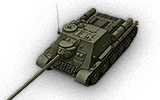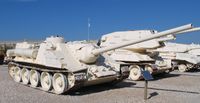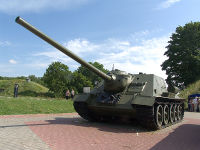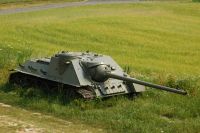SU-100
SU-100 (Stock)
| 908900 Coût |
| 760 PSDurabilité |
| 31.56 / 38.7 Poids |
- Chef de char
- Opérateur radio
- Tireur
- Pilote
- Chargeur
| 75/45/45Blindage caisse(avant/flancs/arrière, mm) |
| 75/60/60Blindage tourelle(avant/flancs/arrière, mm) |
| 500 chPuissance moteur |
| 50 km/hVitesse maximale / en marche arrière |
| 34 °/sVitesse de rotation |
| 200 damage |
| 120 mmPénétration moyenne |
| 6.85121107266436 Temps pour un chargement complet |
| 44 °/sVitesse de rotation du canon |
| 240 mPortée de vue |
| 500 mPortée du signal radio |

The SU-100 is a Soviet tier 6 tank destoryer
It performs much like the SU-85, but has more armor and a much more powerful gun. The 85mm D5S-85BM and the starting 85mm D-5S gun carries over from the SU-85. The 85mm D-5S shows its weakness when fighting tier 7 tanks and above. You should already have the improved 85mm gun, as it is on the SU-85, and use it to get the 100mm, which is suitable for killing fast moving tanks, thanks to its high rate of fire and acceptable penetration power. Finally, you'll gain the option to equip the 122mm D-2-5S, which painfully stings heavy tanks at the expense of firing rate and accuracy.

Canon
| Niveau | Canon | Pénétration moyenne (mm) | Cadence de tir | Dispersion à 100 m | Temps de visée | Expérience | Poids (t) | |
|---|---|---|---|---|---|---|---|---|
| VI | 85mm D-5S | 120/161/43 | 200/200/300 | 8.76 | 0.43 | 2.3 | 0 | 1500 |
| VII | 85mm D5S-85BM | 144/194/44 | 200/200/300 | 7.64 | 0.34 | 2.3 | 15500 | 1850 |
| VII | 100mm D10S | 175/235/50 | 280/280/350 | 6.03 | 0.4 | 2.3 | 16500 | 2257 |
| VII | 122mm D-2-5S | 175/217/61 | 400/400/500 | 3.62 | 0.43 | 2.9 | 17000 | 2600 |

Moteur
| Niveau | Moteur | Puissance moteur (ch) | Probabilité d'incendie à l'impact | Expérience | Poids (t) |
|---|---|---|---|---|---|
| VI | V-2-34M | 520 | 15 | 7320 | 750 |
| VI | V-2-34 | 500 | 15 | 0 | 750 |

| Niveau | Suspension | Limite de charge | Vitesse de rotation (°/s) | Expérience | Poids (t) |
|---|---|---|---|---|---|
| V | SU-100 | 38.7 | 34 | 0 | 8500 |
| VI | SU-100-60 | 38.7 | 36 | 6340 | 8500 |

Radio
| Niveau | Radio | Portée du signal radio (m) | Expérience | Poids (t) |
|---|---|---|---|---|
| IV | _9R_USSR | 500 | 0 | 80 |
Compatible Equipment
Compatible Consumables
Avis des joueurs
Points forts/faibles
Points forts :
- Good choice of guns for different play styles
- Sloped armour
- Has the highest maneuverability of the tier 6 TDs
- Highest alpha damage of all tier 6 TDs
- 122 mm gun can one-shot every tier 4 tank, every SPG up to tier 7 and almost every tier 5 TD (except the AT 2)
Points faibles :
- Poor armor
- High ammo cost (122 mm gun)
- Easily damaged ammo rack
- Tracks are easily broke
Performance
The SU-100 is a support vehicle. Its thin armor and low hit points (even for a TD) means it cannot and will not take much punishment before becoming a smoking wreck. Most tanks your tier and above won't have to aim for weak spots to damage you. However this TD has the biggest punch of its tier, capable of crippling or outright destroying any tank it faces. The choice of higher DPM on the D10S or higher alpha damage on the D-2-5S allows for different styles of play. The 100mm is more suited for true "Tank Destroyer" sniping with a good aim time, decent reload, and acceptable accuracy. The 122mm is suited for ambushes, surprise attacks, and supporting your allies on a push to the enemy base. However its slow aim time and long reload means that after a shot it must find cover. The SU-100 also benefits from good camo, so it can do both roles without the enemy noticing. Overall it is an excellent but tricky tank to master.
Modules prioritaires
- The radio and 85MM D5S-85BM carry over from the SU-85, so mount those immediately.
- Next go for the 100mm gun as its penetration gives this tank the edge.
- It's no longer optional to research the 122mm D-2-5S. However whether you research it before the tracks and engine is up to you.
- The tracks then engine should be next to improve acceleration and manoeuvrability.
- Go up from there.
Informations Historiques
The SU-100 was a Soviet tank destroyer. It was used extensively during the last year of World War II and saw service for many years afterwards with the armies of Soviet allies around the world.
Development
It was developed in 1944 as an improvement to the SU-85, built on the same chassis as the T-34-85 tank. It was designed and built at the UZTM (Russian abbreviature УЗТМ for Уральский Завод Тяжелого Машиностроения - Ural Heavy Machinery Factory, also called Uralmash) in Yekaterinburg. The SU-100 quickly proved itself to be among the best self-propelled anti-tank guns of World War II, able to penetrate 125 mm (4.9 in) of vertical armor from a range of 2,000 m (1.2 mi) and the sloped 85 mm (3.3 in) front armor of the German Panther from 1,500 m (0.93 mi).[citation needed] This was quite capable of defeating any German tank in service, for which Soviet soldiers gave it the obscene nickname "Pizdets vsemu" ("Fucking end to anything").[1] The development was conducted under supervision of L. I. Gorlitskiy, chief designer of all medium Soviet self-propelled guns. The work started in February 1944, and the first prototype of SU-100, called "Object 138", was built in March. After intensive testing with different models of the 100 mm gun, Soviet engineers approved the D-10S gun for mass production. This gun was developed in Constructors Bureau of Artillery Factory No. 9 under guidance of F. F. Petrov. After the Second World War, it was installed on T-54 and T-55 tanks and its derivatives were in service forty years after initial development. The hull of the SU-100 had major improvements over the SU-85; thickness of front the armour plate was increased from 45 to 75 mm (1.8 to 3.0 in), and the commander's workplace was made in a small sponson on the right side of the hull. Combined with the commander's cupola, this greatly improved the commander's effectiveness. For better ventilation, two ventilator units were installed instead of only one as in the SU-85. Mass production began in September 1944.
In service
The SU-100 saw extensive service during the last year of the war. It was used en masse in Hungary in March 1945, when Soviet forces defeated the German Operation Frühlingserwachen offensive at Lake Balaton. By July 1945, 2,335 SU-100s had been built. The vehicle remained in service with the Red Army well after the war: production continued in the Soviet Union until 1947 and into the 1950s in Czechoslovakia. It was withdrawn from Soviet service in 1957, but many vehicles were transferred to reserve stocks. Some exist to this day in the Russian Army holding facilities. Many Warsaw Pact countries also used the SU-100, as did Soviet allies such as Egypt, Angola, and Cuba. The SU-100 saw service in the fighting that accompanied the 1956 Suez Crisis, in which the Egyptians used SU-100s against Israel's M4 Sherman tanks. The vehicle was also utilised in the 1967 Six-Day War and the 1973 Yom Kippur War. It was modified slightly to adapt it to the sandy conditions of the Middle East, thus creating the SU-100M variant. Exported SU-100s continued in service until the 1970s, and in some countries, even later. The SU-100 remains in use by the Vietnam People's Army and the Korean People's Army Ground Force despite the age of the design. SU-100s entered service with the People's Liberation Army (PLA) of China in 1955 after Soviet forces left Dalian. The armaments in Dalian were sold to China, including 99 SU-100s, 18 IS-2 heavy tanks, 16 T-54s and 224 T-34s, with which PLA formed into the 1st Mechanised Division.
In popular culture
The crew of a World War II SU-100 and their vehicle are the heroes of the old Soviet film «На войне как на войне» Na vojne kak na vojne ("Alls fair in love and war" (literally: "In wartime its like wartime")), one of several Soviet films made about self-propelled artillery men. Veterans of the German-Soviet War found this picture quite realistic. The movie includes a Soviet tankmen song, which is popular with both Russian armoured soldiers and civilians.
Sources et Liens Externes
| Light Tanks | |
| Medium Tanks | |
| Heavy Tanks | |
| Tank Destroyers | |
| Self-Propelled Artillery |
| USA | |
| UK | |
| Germany | |
| USSR | |
| China | |
| Japan |



